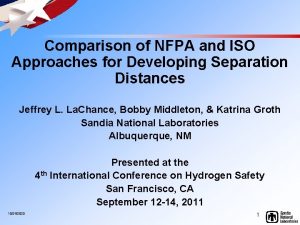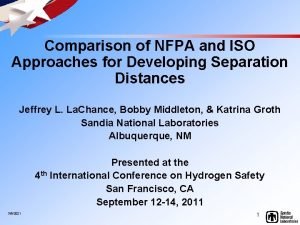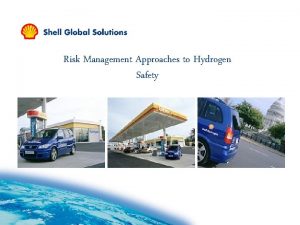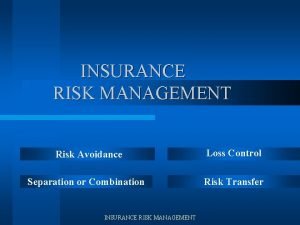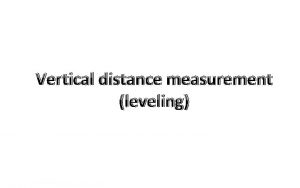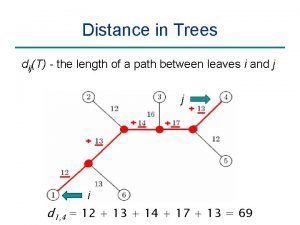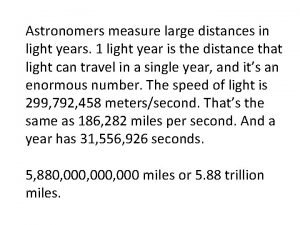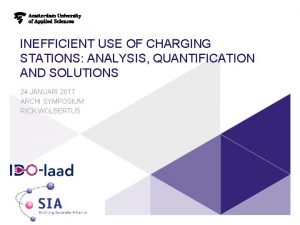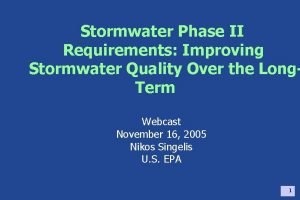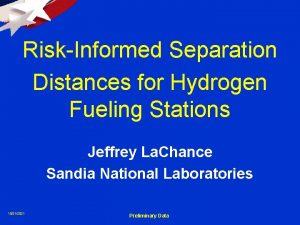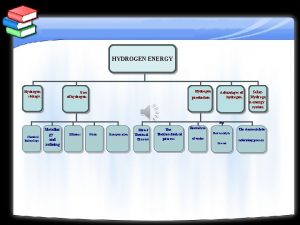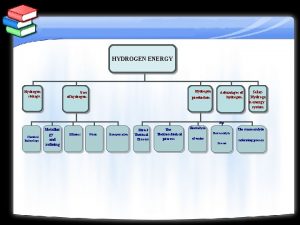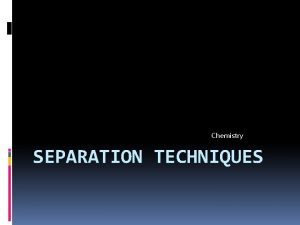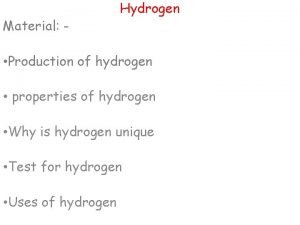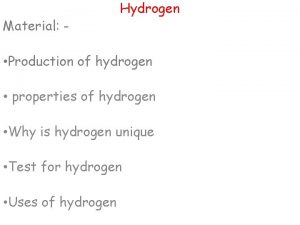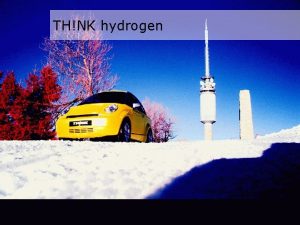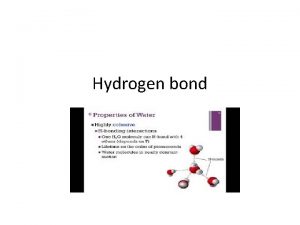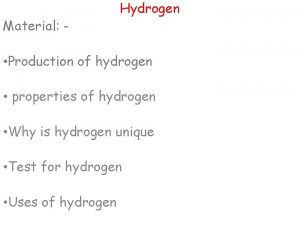Risk informed separation distances for hydrogen refuelling stations





















- Slides: 21

Risk informed separation distances for hydrogen refuelling stations ¢ ¢ Frederic Barth Air Liquide Hydrogen Energy International Conference on Hydrogen Safety 2011 – San Francisco, 12 Sept 2011

Background and general motivation ¢ Approach developed for ISO/DIS 20100 Gaseous Hydrogen – Fuelling stations within TC 197/WG 11 Fueling stations by TG 1 Separation distances ¢ To substantiate lay-out requirements for HRS sub-systems ¢ Applied to gaseous hydrogen systems a a ¢ Hydrogen supply system (e. g. tube trailer) Hydrogen compression skid Hydrogen buffer storage Hydrogen dispensers Hydrogen is being developed for generalized use as an energy carrier: a Higher operating pressures than previously considered a Installation and use in public settings a Variety of applications (e. g. RV fuelling stations, back-up power, materials handling…) ¢ Inherently safe designs and built-in safety measures Need of a robust rationale and approach for addressing these new applications consistently ICHS 2011 – San Francisco, 12 Sept 2011 2

Separation distances in codes & standards Rationale ¢ Purpose : a generic means for mitigating the effect of a foreseeable incident and preventing a minor incident escalating into a larger incident (EIGA IGC 75/05) ¢ Apply separation as appropriate, along with other means, to achieve freedom from unacceptable risk ¢ Separation is not always necessary, nor most appropriate means ¢ Where applied, appropriate separation can be defined by application of a risk criterion ¢ Protection against catastrophic events is essentially achieved by other means than separation, such as prevention, specific means of mitigation, or emergency response, which are also addressed. ICHS 2011 – San Francisco, 12 Sept 2011 3

Separation distances in codes & standards Form of specification ¢ Continue to express requirements by means of a good table that is suitable for the covered application a Most practical a Tabled distances have been checked a Same distance for similar systems supports standardization a Relying on a formulas raises the risk that design parameters will be chosen to minimise safety distance requirements although this choice does not reduce the actual risk level to exposures a Practical value added of specifying distance by means of formulas is not clear ¢ Different applications may require different tables a e. g. Fuelling stations, bulk hydrogen storage systems, hydrogen installations in non industrial environment ICHS 2011 – San Francisco, 12 Sept 2011 4

Table based separation distances specification – Basic steps Table Lines : Exposures or sources of hazard ; Columns: system category 1. Select system characteristics that fundamentally determine actual risk impact 2. Define system categories associated to a graduation of risk impact a Taking into account different types of equipment actually used a Limit the number of categories to justified need 3. Use a risk model to determine the separation distances for each category, by application of a criterion on estimated residual risk, a Based on max values for the category a Higher risk Greater separation 4. Populate the distance table and evaluate the result. ICHS 2011 – San Francisco, 12 Sept 2011 5

Selection of system characteristics that fundamentally determine actual risk impact ¢ Separation distances should not be determined only by Pressure and Internal Diameter. Need to integrate fundamental factors determining actual risk impact, such as inventory, system complexity, and exposure criticality ¢ Over sensitivity to a detail design parameter such as internal diameter needs to be avoided ICHS 2011 – San Francisco, 12 Sept 2011 6

Selection of system characteristics that fundamentally determine actual risk impact 1. Storage system size a Small a Large 2. Complexity level as reflected by number of components a Very simple (for Small systems only) a Simple a Complex 3. For Small systems only : pressure a Regular a High ICHS 2011 – San Francisco, 12 Sept 2011 7

Categorization of compressed hydrogen storage systems ¢ Boundaries defined according to equipment types in use ICHS 2011 – San Francisco, 12 Sept 2011 8

Resulting categorization for gaseous hydrogen storage systems ¢ 8 categories ICHS 2011 – San Francisco, 12 Sept 2011 9

Risk model for determination of a separation distance requirement from a system occ. /yr Separation distance To be applied Frequency 10 -1 1 10 3 30 Separation distance (m) Leaks Cumulated frequency of feared effects from leaks greater than X g/s 10 -2 10 -3 10 -4 Feared Effect Target 10 -5 10 -6 0, 01 0, 1 1 10 100 Leak rate (g/s) Reference leak size ICHS 2011 – San Francisco, 12 Sept 2011 10

Key parameters of risk model ¢ Cumulative leak frequency vs leak size See next slides ¢ Probability of having the feared event (injury) when a leak occurs Pignition x Geometric factor = 0, 04 x 0, 125 = 0, 005 ¢ Consequence model providing distance up to which leaks can produce the feared event, in function of leak size and type of feared effect (e. g thermal effects or 4% H 2 concentration) Sandia National Laboratories jet release and fire models ¢ Target value for the feared event frequency, Non-critical exposure: 10 -5 /yr Critical exposure: 4 10 -6/yr ¢ Risk model does not provide an accurate evaluation of risk, but allows to take into consideration the main risk factors consistently Separation distances are risk informed ICHS 2011 – San Francisco, 12 Sept 2011 11

Determination of system leak frequency distribution in function of component leak frequency distribution ¢ Consider main contributors to leaks a Joints, Valves, Hoses, Compressors ¢ Estimate cumulated leak frequency in function leak size (% of flow section) for each type of component, from available statistical data ¢ Estimate cumulated leak frequency in function of leak size for the whole system, by summation of contributing component leak frequency data ICHS 2011 – San Francisco, 12 Sept 2011 12

Component leak frequency – Source of input to risk model ¢ Risk model requires leak frequency input for following leak size ranges : [0. 01% ; 0, 1%], [0. 1% ; 1%][1% ; 10%][10% ; 100%] ¢ Use of published leak frequencies compiled by SNL (J. La. Chance) Extract for valves, where information on leak size is provided (34% of records): ¢ Data input to risk model: Leak size range [0. 01% ; 0, 1%] [0. 1% ; 1%] [1% ; 10%] [10% ; 100%] Log. average freq. of extrapolated “Small leaks” “Large leaks” “Ruptures” ICHS 2011 – San Francisco, 12 Sept 2011 13

Risk model leak frequency input for valves (1) ¢ Frequency and size of “small leaks” ICHS 2011 – San Francisco, 12 Sept 2011 14

Risk model leak frequency input for valves (2) ¢ Frequency and size of “small leaks” ICHS 2011 – San Francisco, 12 Sept 2011 15

Risk model leak frequency input for valves (3) ¢ Note : adequacy of using log-average of “Small leak”, “Large leak”, and “Rupture” frequencies as risk model input for [0. 1% ; 1%], [1% ; 10%], [10% ; 100%] ranges was verified for all types of components ICHS 2011 – San Francisco, 12 Sept 2011 16

Risk model component leak frequency functions ICHS 2011 – San Francisco, 12 Sept 2011 17

Consequence Model ¢ Interpolation of flame length and flammable cloud length formulas developed by SNL (Bill Houf) : ICHS 2011 – San Francisco, 12 Sept 2011 18

Risk informed leak diameters & separation distances for storage/transfer systems ICHS 2011 – San Francisco, 12 Sept 2011 19

Separation distance requirements for compressed for gaseous hydrogen storage/transfer systems ICHS 2011 – San Francisco, 12 Sept 2011 20

Thank you frederic. barth@airliquide. com ICHS 2011 – San Francisco, 12 Sept 2011 21
 Nfpa separation distances
Nfpa separation distances Nfpa separation distances
Nfpa separation distances Liquidity measures
Liquidity measures Alarp matrix
Alarp matrix Separation risk control technique
Separation risk control technique Gas particles are separated by relatively large distances
Gas particles are separated by relatively large distances Vertical distance measurement
Vertical distance measurement Tree distances i
Tree distances i Two towers face each other separated by a distance d=20
Two towers face each other separated by a distance d=20 The furthest distance ive travelled analysis
The furthest distance ive travelled analysis It is the distance covered per unit of time
It is the distance covered per unit of time Winds that blow over short distances are called
Winds that blow over short distances are called Clockwise time of hexagon agility test
Clockwise time of hexagon agility test Ted likes to run long distances
Ted likes to run long distances Far distances
Far distances Astronomers measure large distances
Astronomers measure large distances Navigation using speed, distance and time calculations
Navigation using speed, distance and time calculations How do waves form
How do waves form Images of weather systems on television come from *
Images of weather systems on television come from * Easterlies
Easterlies Charging stations
Charging stations Types of transfer stations in solid waste management
Types of transfer stations in solid waste management
